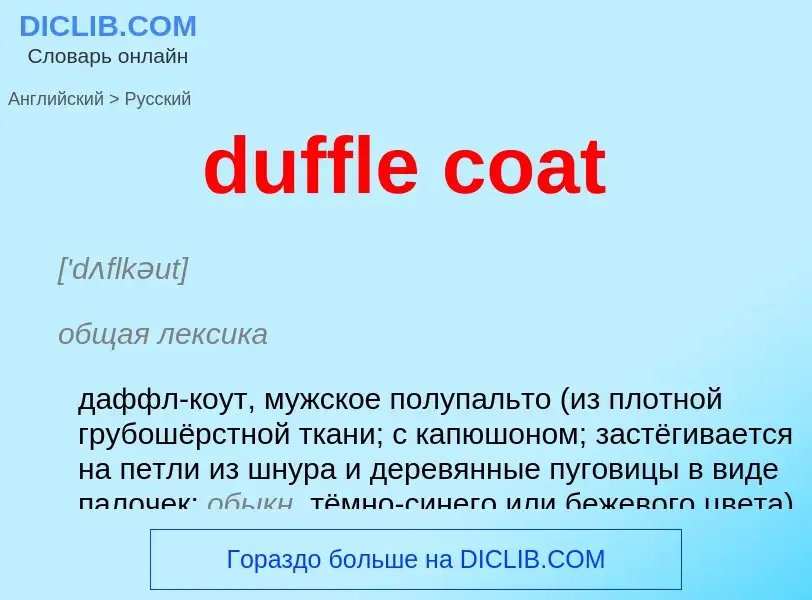Vertaling en analyse van woorden door kunstmatige intelligentie ChatGPT
Op deze pagina kunt u een gedetailleerde analyse krijgen van een woord of zin, geproduceerd met behulp van de beste kunstmatige intelligentietechnologie tot nu toe:
- hoe het woord wordt gebruikt
- gebruiksfrequentie
- het wordt vaker gebruikt in mondelinge of schriftelijke toespraken
- opties voor woordvertaling
- Gebruiksvoorbeelden (meerdere zinnen met vertaling)
- etymologie
duffle coat - vertaling naar russisch
['dʌflkəut]
общая лексика
даффл-коут, мужское полупальто (из плотной грубошёрстной ткани; с капюшоном; застёгивается на петли из шнура и деревянные пуговицы в виде палочек; обыкн. тёмно-синего или бежевого цвета)
название по бельгийскому г. Дюффелю, где первоначально вырабатывалась ткань для таких пальто
['dʌf(ə)lkəut]
общая лексика
мужское пальто свободного покроя
обыкн. с капюшоном и с застёжкой на деревянные пуговицы
строительное дело
накрывка из белого известкового штукатурного раствора
Wikipedia

A duffel coat (also duffle coat) is a coat made from duffel cloth, designed with toggle-and-rope fastenings, patched pockets and a large hood. The name derives from Duffel, a town in the province of Antwerp in Belgium where the manufacturing process of this kind of fabric, a coarse, thick, woolen cloth originated. Duffel bags were originally made from the same material.
As the hood and toggle fastenings from Polish frocks proved popular, the frock spread across Europe by the 1850s. By 1890 a less sophisticated version was being supplied to the British Royal Navy, from various manufacturers. During World War II all British troops wore the coat, among them Field Marshal Sir Bernard Montgomery and Lieutenant-Colonel Sir David Sterling. After the war, the coats became available in England as government surplus stock and became popular, especially with students. In countries freed by British troops from Nazi-German occupation, wearing the coat also meant a tribute to all troopers that fought in the war and a statement to civilian freedom.


![A [[Royal Navy]] officer wearing a duffel coat aboard a destroyer on convoy protection duties, 1942 A [[Royal Navy]] officer wearing a duffel coat aboard a destroyer on convoy protection duties, 1942](https://commons.wikimedia.org/wiki/Special:FilePath/A Royal Navy officer using a sextant aboard a destroyer on convoy protection duties, 1942. TR92.jpg?width=200)

.jpg?width=200)
![Scottish singer [[Alex Kapranos]] in a contemporary duffel coat Scottish singer [[Alex Kapranos]] in a contemporary duffel coat](https://commons.wikimedia.org/wiki/Special:FilePath/Duffle coat.jpg?width=200)

